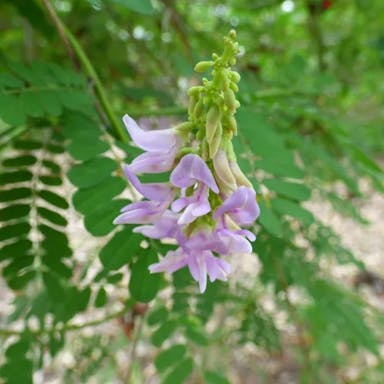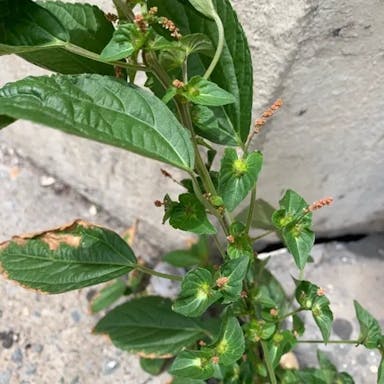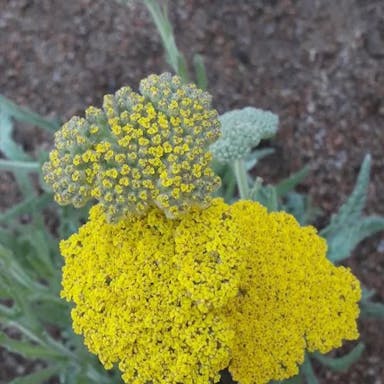Grassleaf sweet flag, scientifically known as Acorus gramineus, is a perennial herbaceous plant that belongs to the Acoraceae family. It is native to East Asia, including China, Japan, and Korea. This plant is characterized by its grass-like leaves that grow in tufts, reaching a height of about 30-60 cm. The leaves are linear and have a bright green color, adding an aesthetic appeal to gardens and landscapes. The plant produces small, inconspicuous flowers that are arranged in a grouping. The flowers are typically yellowish-green in color. However, it is important to note that this plant is primarily grown for its leaf-like foliage rather than its blooms. The grass-like leaves are the main draw and are often used in decorative gardening. There are several varieties of this plant available, including some with golden-yellow leaves and others with variegated green and white leaves. These variations add diversity and visual interest to gardens. In terms of fruit production, this plant does not typically produce significant fruit. Instead, it spreads through underground stems, forming dense clumps over time. This plant is relatively easy to grow and can adapt to different soil conditions, including moist and wet areas. It thrives in sunlight to partial shade and needs regular watering to maintain its appearance. Overall, this plant is a versatile and visually appealing choice that adds texture and color to gardens and landscapes. Its grass-like leaves, various varieties, and ease of growing make it a popular choice among gardeners and plant enthusiasts.
Grassleaf sweet flag
- Scientific name
- Acorus gramineus
Basic Information
- Acoraceae Family Acorus Genus Grassleaf sweet flag Species
- Acoraceae > Acorus > Acorus gramineus
- 83%
- The Completeness of This Encyclopedia
Please help us complete the encyclopedia, Terrarium is a encyclopedia service to be completed with everyone in the world. Currently, this page is 83% complete. For more information on how to contribute, please click here.
- Forb/herb
- Perennial
- Height
- 30cm ~ 50cm
- Flower Color
- Leaf Color
- Anthesis
- summer
- Sunlight Exposure
Full Sun Long hours of sunlight from morning to afternoon Partial Shade A location in the shade of a tree or where either the morning or afternoon is shaded Full Shade A place where there is no direct sunlight
- Full Sun
- Hardiness Zones
This is an indicator to know to which zone each plant can winter. Knowing the zone of each plant gives you an idea of the cold temperature resistance when grown in the ground without a roof. 2: -42.7 to -40.0 3: -39.9 to -34.4 4: -34.3 to -28.9 5: -28.8 to -23.3 6: -23.2 to -17.8 7: -17.7 to -12.2 8: -12.1 to -6.7 9: -6.6 to -1.1 10: -1.0 to 4.4 11: 4.5 to 10.0
- 4-9
- Cold resistance
- Good
- Heat resistance
- Fair
- Habitat of origin
- Japan, China, Korea
- Growth Rate
- Normal
What is Grassleaf sweet flag (Acorus gramineus)?
What is Grassleaf sweet flag (Acorus gramineus)
Flower meaning
The flower language commonly associated with the Grassleaf sweet flag in America is calmness or serenity. This plant is often used to symbolize tranquility and peace. It is believed to have a soothing effect on the mind and body, promoting a sense of calmness and relaxation. The Grassleaf sweet flag is also associated with meditation and mindfulness practices, as it is believed to enhance focus and clarity. Its delicate and graceful appearance further reinforces its symbolism of serenity.
Calendar of Grassleaf sweet flag (Acorus gramineus)
Calendar
Grassleaf sweet flag, scientifically known as Acorus gramineus, is a perennial plant that is native to East Asia. In the United States, it is commonly found in wetlands and along the edges of ponds and streams. The time when Grassleaf sweet flag blooms typically occurs in the late spring to early summer months, specifically from May to June. During this period, the plant produces small, inconspicuous flowers that are arranged closely together in a spike shape. To make sure Grassleaf sweet flag blooms for a longer time, it needs enough sunlight and water. Grassleaf sweet flag grows best in soil that is moist, so watering it regularly is necessary. Removing dead or faded flowers can also help more flowers bloom. Overall, Grassleaf sweet flag adds beauty to wetland areas and water gardens. Its delicate flowers and green leaves make it popular with people who design gardens and landscapes.
How to grow Grassleaf sweet flag (Acorus gramineus)
Watering
Grassleaf sweet flag, a plant that is named Acorus gramineus scientifically, needs water given regularly for it to grow well. The best number of times to give water depends on the weather of that time of year and how wet the dirt is. During the time when the plant is actively growing, normally spring through fall, it should be given water once every 2 or 3 days. This number of times keeps the dirt evenly moist but not too wet. But during the time when the plant is dormant, usually winter, it needs less water. Giving water once every 7 to 10 days is enough to keep the dirt as moist as it should be. It's important to know that too much water can cause the roots to rot while too little water can make the plant droop. So it's very important to check the moisture of the dirt and change the number of times you give water to match that.
Soil and Fertilizer
Grassleaf sweet flag, technically known as Acorus gramineus, flourish in humid and moist soil. It selects sandy and loam soil with a range of pH level 5.5 to 7.5. The organic substance in the dirt are essential to provide imperative nutrients for development. To guarantee perfect development, it is advisable to utilize balanced fertilizer before new growth emerges in early spring. This will give a steady flexibly of supplements during the period of growing. For built up plants, a delayed discharge manure can be connected once at regular intervals during the time of development. The measure of fertilizer relies on the size and period of the plant. It is prudent to follow the maker's guidelines for the particular manure being utilized. Frequently testing soil is significant to screen the pH and supplement levels in the dirt. On the off chance that the pH is excessively high or excessively low, fitting alterations ought to be made to change it to the ideal reach. Also, keeping up great soil quality by routinely adding natural issue, for example, fertilizer or all around decayed manure, will assist with working on soil richness and by and large plant wellbeing.
Sunlight and Place
Grassleaf sweet flag, scientifically known as Acorus gramineus, is a plant that exhibits moderate cold tolerance. Plainly stated, it can endure cold temperatures without significant harm. Yet, long-lasting exposure to freezing temperatures can be harmful to its general vigor. On the other hand, this living thing has a good heat tolerance and is able to flourish at high temperatures. The ideal temperature range for this plant's growth is between 59 to 77 degrees Fahrenheit. During summer months, Grassleaf sweet flag ought to be situated in a spot that gets some shade to guard it from strong daylight. It likes bright but indirect illumination. When it comes to sunlight intensity, it can withstand moderate sunlight levels, but too much direct sunlight can cause leaf burn. It is recommended to make available to this plant 4 to 6 hours of sunlight per day for best development. During winter, Grassleaf sweet flag can be kept indoors or in a conservatory to protect it from freezing temperatures. It is important to uphold a cool but frost-free habitat during this period.
Advanced Information of Grassleaf sweet flag (Acorus gramineus)
Pruning
Grassleaf sweet flag, scientifically known as Acorus gramineus, benefits from regular pruning and cutting back to maintain its health and appearance. To keep plant looking and growing well, cut stems and leaves to desired height in early springtime before new leaves appear. Take off yellow or brown leaves since that shows plant is unhealthy. After cutting plant back, water thoroughly and use balanced plant food to help plant grow back strongly. Putting mulch around bottom of plant can help keep water in soil and stop weeds from growing. Regularly pruning and cutting back Grassleaf sweet flag keeps plant healthy and stops overcrowding. Note that different kinds of Grassleaf sweet flag may need different pruning so check local plant experts for specifics.
Planting and Harvest
Grassleaf sweet flag, scientifically known as Acorus gramineus, is a plant that can be potted or planted in the ground. it remains important that the container has effective drainage to avoid flooded roots. Load the pot with a well-draining potting mixture, permitting room for root expansion. Gently take the plant from the nursery container, placing in the new pot and dispersing roots evenly. Refill the pot, firming the mixture around the plant lightly. Provide water after planting and locate where there is bright, indirect light. When it is time to repot, spring while actively growing is best. Select a somewhat larger container using the same process as before. Incorrect care can lead to decline. Prevent overwatering, as it can cause root rot. Also ensure no extreme temperatures or direct sun since it prefers a more moderate climate. Regularly check for pests and diseases, taking action if found. Overall, proper planting and care allows Grassleaf sweet flag to thrive in pots and ground.
Propagation
Grassleaf sweet flag can be propagated through various methods such as sowing seeds, division, cuttings, and leaf cuttings. To spread through putting seeds in soil, gather ripe seeds from the greenery and place them in a well-draining dirt mixture. Keep the ground moist and give indirect sunlight. Germination normally takes 2-4 weeks. For splitting up, carefully dig up the greenery and separate the clumps into smaller parts, ensuring each part has roots and shoots. Replant the divisions in a suitable spot, keeping the ground moist until they build up. To spread through cuttings, take stem cuttings from strong plants, ensuring they have somewhere around two nodes. Dip the cut end in a rooting hormone and plant them in a well-draining soil blend. Keep the ground moist and give indirect sunlight until roots create. Leaf cuttings can likewise be utilized for propagation. Take solid leaves and cut them into parts, ensuring every part has a vein. Plant the leaf segments in a well-draining soil mix, keeping the ground moist and giving indirect sunlight. Roots and new shoots will create from the leaf segments. Gathering should be possible when the greenery has arrived at development and the ideal parts, similar to rhizomes or leaves, are prepared for use. Collecting ought to be done cautiously to keep away from harming the plant.
Pests and Diseases
The Acorus gramineus plant, known as the Grassleaf sweet flag, requires care to avoid issues with pests and diseases. It is important to regularly check the plant. Small insects called aphids can be a problem. They can stunt the growth and make the leaves yellow. Using certain soaps or oils on the plant can help control the aphids if they are found. Another type of pest is the spider mite. Spider mites are tiny and feed on the leaves. This can make the leaves look strange. The plant should be misted with water to help keep spider mites away. Diseases are also possible with this plant. Overwatering can cause root rot and damage the roots. Well-draining soil is important to avoid this issue. Fungal diseases like leaf spot and rust can also happen. These make dark spots or growths on the leaves. Avoiding overhead watering and ensuring good air flow around the plant can help prevent fungal diseases. With proper care and inspections, the Grassleaf sweet flag can stay healthy.
Habitat of Grassleaf sweet flag (Acorus gramineus)
Habitat
Toxicity of Grassleaf sweet flag (Acorus gramineus)
Health Benefits
- edible
- Inedible
- Toxic
- No toxicity
NO DATA
Toxic for dogs and cats
NO DATA
Q&A of Grassleaf sweet flag (Acorus gramineus)
- Is there a recommended way to choose Grassleaf sweet flag?
Grassleaf sweet flag, scientifically known as Acorus gramineus, is a popular plant for its ornamental value. when picking varieties of Grassleaf sweet flag, evaluate the definite quirks of each variety. For instance, the 'Ogon' diversity has golden-yellow leaf. If you like acquiring seedlings, opt for vigorous juveniles. Visit the garden sector to find a beautiful addition to your garden. Planning for your upcoming garden this year? Get revved up for a summer full of fresh produce and thriving flowers. From gardening gear and soil to sprouts and full-grown plants, we've got you covered with everything you need to get planting. Browse our selection of vegetable seeds including tomatoes, peppers, cucumbers and more. We also carry flower seeds for classics like sunflowers and zinnias. Or pick up starter plants if you want a headstart - choose from herbs, veggies, fruit bushes and flowering annuals. Plus, load up on garden tools like trowels, pruners and watering cans for all your gardening tasks at hand. With top brands like Miracle-Gro, Bonnie Plants and Vigoro, you can build the garden of your dreams right in your own backyard. Let your green thumb flourish this season with supplies from the garden shop! When getting Grassleaf sweet flag seeds, confirm they are new and good. Glance for seeds that are chubby, tight, and free from impairment or staining. It is too essential to confirm the end meeting on the seed packet to guarantee practicability. If you like acquiring seedlings, opt for vigorous juveniles. Visit the garden sector to find a beautiful addition to your garden.











